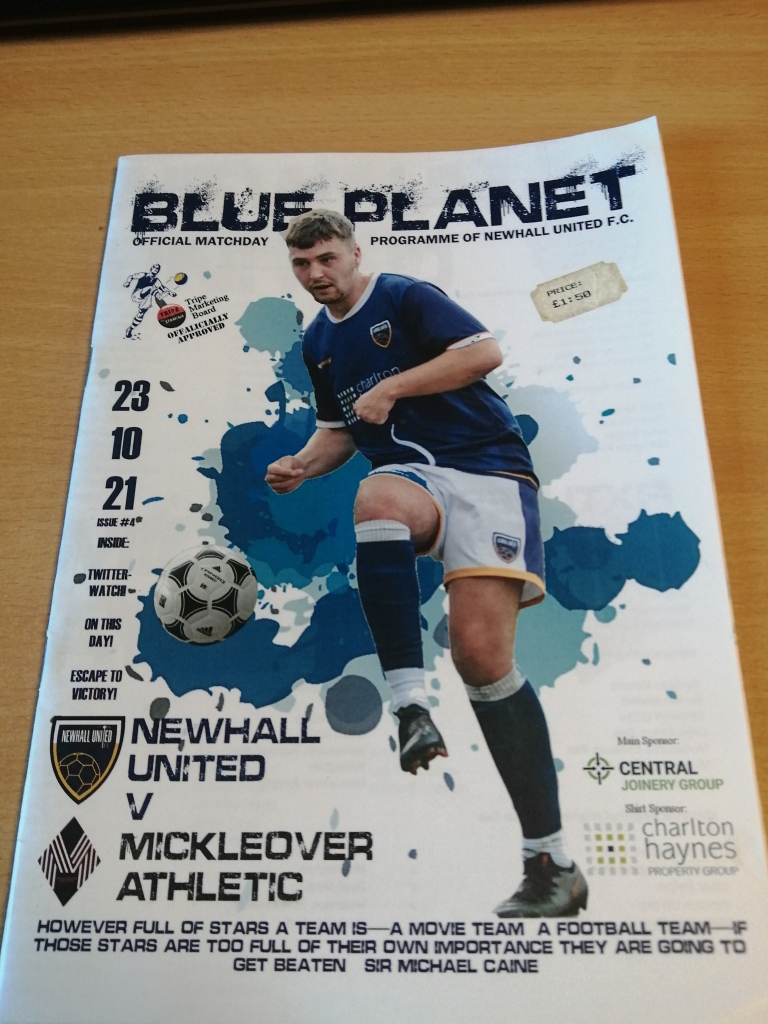29th September 2018
St Martins v Rylands
NorthWest Counties League Division 1 South
Programme Price: £2

As I am a fellow Salopian it probably comes as no surprise when I say that I’ve seen the Shropshire club, St Martins several times over the years. The club is one of the friendliest you could wish to come across in non-league football and they always produce a fantastic programme. Ironically, the programme I have chosen for today’s review isn’t from a St Martins game that I attended. I obtained this issue from my last visit to watch the club (against FC Isle of Man, last season) as they were selling programmes from games played previously.
This near four year old programme consists of 36 pages from the front to back cover, and although there are 15 pages adverts, it is not detract from the enjoyment of reading it.
With page 1 being the front cover, page 2 provides a full page advert with the following page featuring a programme contents list as well as advertising the club’s next home game on 19th October 2018 against Cammell Laird.
Page 4 provides a guide as to who’s who at the club as well stating the year the club was formed (1887) at the time of writing, the chairman was named as Terry Ellis and the manager was Dan Stevens. The manager then gives his thoughts on the following page and amongst other things makes reference to the fact that the game against Rylands would only by the club’s fourth game at home out of thirteen played across all competitions.
Pages 5 and 6 make for very interesting reading as they provide a history of St Martins Football Club. As previously mentioned, the club was founded in 1897 and in those early days the Shropshire club competed in the Oswestry & District League. In the 1930/1931 season, one of the best teams to represent the village and captained by Tom Vaughan, won the village cup by beating Traflach in the final. One of the players for St Martins that day was Don Hopley who later played for both Shrewsbury Town and Wellington Town respectively. St Martins won the Oswestry league in 1953 and 1955 and in the years to 1966 they won the village cup ten times! In the early 1990’s the club joined the Shropshire County League and won the 1993/1994 Challenge Cup. By the 2010/2011 campaign, St Martin were competing in the West Midlands Regional League Division Two and gained promotion to Division One at the first attempt. The club secured promotion to the Northwest Counties League Division One South for the 2017/2018 season and during that same season they competed in the FA Vase for the first time in their history.
Pages 7 to 10 provide player sponsorship details whilst page 11 features two adverts. The following page provides a photograph of the St Martins FC committee members.
Page 12 is an advert and followed on page 13 with previous results and forthcoming fixtures for the 2018/2019 season. St Martins started their season with a 1-0 defeat at Barnton with their next game after the Rylands encounter being away at New Mills.
Page 14 is another advert with page 15 providing the Northwest Counties League Division One South table. This game would be a real top of the table clash because at the time of writing, St Martins were in 2nd position whilst their opponents, Rylands were at the top of the table.
Pages 16 and 17 feature information on Rylands Football Club – Rylands Recreation Club were formed as a local works (wire manufacturer) team in 1911 and in those early days they played in the Liverpool County Combination before joining the Warrington & District League. Rylands won several Warrington & District League titles throughout the 1950’s and in 1969 they joined the Mid-Cheshire League. Ten years after joining they beat Barnton in the League Cup Final. Fast forward twenty years and the club reached another Mid-Cheshire League Cup Final but were lose on penalties against Knutsford. After falling on hard times, the club amalgamated with Crosfields in 2008 to form a new club, Crosfields/Rylands but prior to the start of the 2012/2013 season, the club resumed the name of Rylands FC. The 2018/2019 Northwest Counties league Division One South season would be the first time they had competed at step 6 of the non-league game in their 107 year history.
Page 18 is an advert with the following page providing a match report from St Martins recent 4-0 victory at Stone Dominoes, an excellent display of attacking football by all accounts!
Pages 20 and 21 are both adverts with the following two pages showing a photograph from the club’s recent 4-3 defeat at Vauxhall Motors. The next three pages all contain adverts with page 27 showing player statistics. At the time of writing the top scorer was Tawanda Melusi with five goals from twelve appearances.
Page 28 is an advert with page 29 providing a short piece written by Saints supporter, Dave Bennett who started following the club four years previously when his son, Calum signed for them at the age of 17. The following pages provide several adverts before the programme is completed on the back cover with the team squad lists.

All in all and I like I said earlier, despite the amount of adverts this is still a very enjoyable programme to read and I hope those of you reading this have enjoyed my review of it.


















